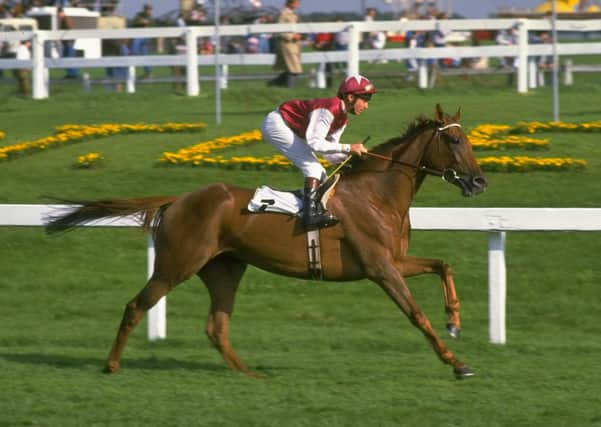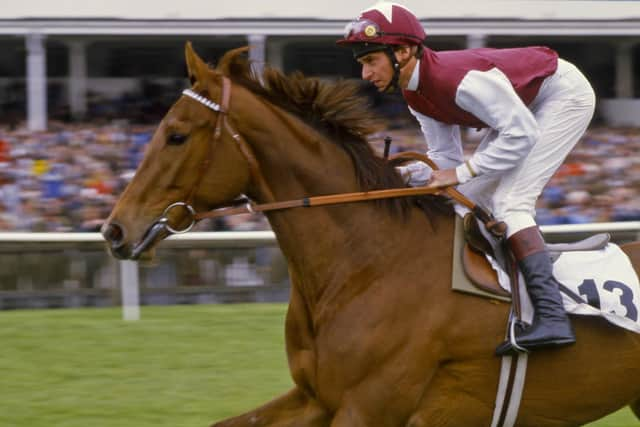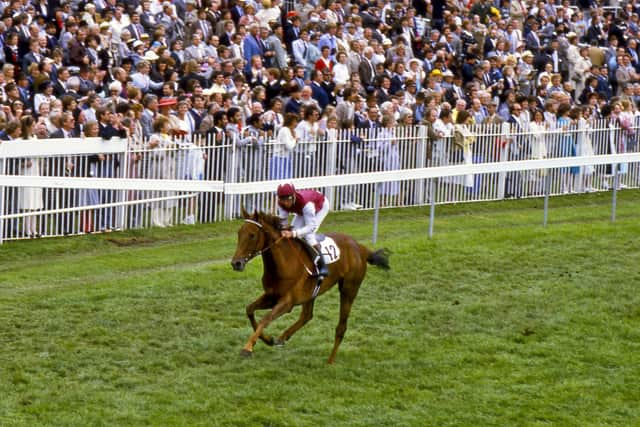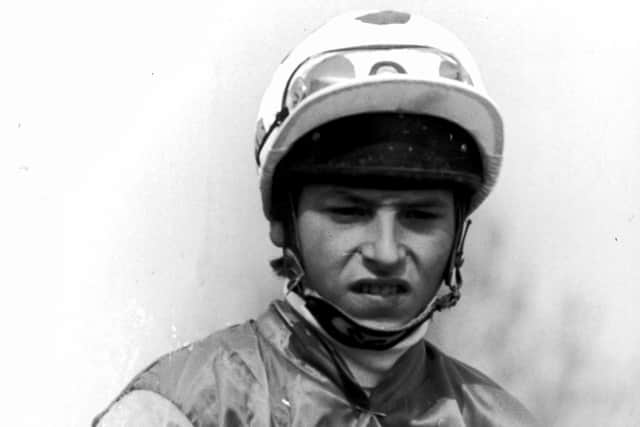Jockey Steve Cauthen anoints Triple Crown heroine Oh So Sharp as greatest filly


The only jockey to do so, the fact that he also rates the majestic filly Oh So Sharp as highly as Affirmed, the equine legend that had catapulted him to sporting super-stardom in America, speaks volumes.
She had won the 1000 Guineas and Epsom Oaks before two disappointing defeats left the Henry Cecil-trained and Sheikh Mohammed-owned horse with a point to prove as she headed to Doncaster for the 1985 St Leger.
Advertisement
Hide AdAdvertisement
Hide AdHere the baby-faced Cauthen used all his experience, hitting the front with two furlongs to go, and allowing the Yorkshire faithful to see him, and Oh So Sharp, in full flight on a day of history under summer sunshine.


She became just the second winner of the fillies’ Triple Crown, the other being Meld in 1955, since the war – while the Lester Piggott-inspired Nijinsky’s Triple Crown win exactly 50 years ago was the last by a colt.
Her Leger victory saw the late Cecil become the first trainer to accrue prize money in excess of £1m in a single season.
And it saw the mercurial Cauthen, then 25, replicate the success he had enjoyed seven years earlier when his association, as a boyish 18-year-old, with Affirmed’s Triple Crown success in 1978 – the Kentucky Derby, Preakness Stakes and Belmont Stakes – saw him named the Sports Illustrated Sportsman of the Year, one of the ultimate accolades.
Advertisement
Hide AdAdvertisement
Hide Ad“Oh So Sharp – she was the reason I wanted to ride for Henry,” the legendary jockey always known as ‘Kentucky Kid’ told The Yorkshire Post in an exclusive interview.


“I saw her as a two-year-old and she looked like a good filly.” Note the word “good” – Oh So Sharp still wasn’t guaranteed greatness after landing Sandown’s Solario Stakes, and the Fillies Mile at Ascot, under the aforementioned Piggott.
By St Leger night in September 1985, he had reappraised his view to “great”. Now, 35 years later with the benefit of hindsight, the assessment is complete. “She was the best filly I rode.”
He meant it too – this, after all, was a year of domination that saw the cherubic Cauthen win four out of the five Classics (only the 2000 Guineas eluded him).
Advertisement
Hide AdAdvertisement
Hide AdBut racing’s small margins were epitomised by the American jockey driving Oh So Sharp to the line in the last stride of the mile-long 1000 Guineas at Newmarket.


The race looked between Sir Michael Stoute’s Bella Colara, ridden by a Piggott motivated by no longer being on Oh So Sharp and on the cusp of his first ‘retirement’ as tax inquiries began, and Al Bahathari, until both were cut down by Cauthen.
As racing broadcaster Brough Scott observed: “We had not reckoned on quite what an engine and a desire lay within the filly’s long chestnut frame, nor with the galloping crescendo Cauthen could conduct.”
Poetic words, Cauthen’s appraisal is more modest. The filly, he said, needed good ground to be seen at her best and she won “in spite of the going”. “She was never travelling happily and she flew down the hill and got her head in front on the line,” said the 60-year-old.
Advertisement
Hide AdAdvertisement
Hide AdIn contrast the undulating mile and a half Oaks at Epsom, the second leg, was a regal procession against fillies of the calibre of Triptych, herself a multiple Group One winner who Cauthen rode to many great triumphs. The six length victory – emphatic for a Classic – was almost as comfortable as Slip Anchor’s runaway Derby win 72 hours previously. “She just raced for fun on ground that suited her,” he said.
But it is typical of the great jockeys that they also remember just as vividly, if not more so, the races that eluded them and Cauthen is no different.
He blames himself for Oh So Sharp’s defeat in Ascot’s King George by the fast finishing Petoski – he had hit the front too soon and was a sitting target – and bottomless ground at York for the horse’s defeat to 1984 St Leger winner Commanche Run, and a certain Lester Piggott, in the Benson and Hedges International. “It was knee-deep and she couldn’t plough through it as good as him,” he recalled.
They were lucky, he says, not to have lost the Triple Crown in the attritional Knavesmire mud before Oh So Sharp stepped up to the St Leger trip of a mile and six furlongs.
Advertisement
Hide AdAdvertisement
Hide AdA distance that had proved too much for many equine greats, notably Shergar, Cauthen saw it like this. “She had had a long season. I was confident that she would stay and it was just a question of if she was okay in herself,” he ventured.
Tucked in for most of the race, they were never under serious threat from the Piggott-ridden Lanfranco once in front to cacophonous cheers.
“In a fair world, she would never have been beaten. Ascot was my fault and York, perhaps we should not have run her. She should have been an undefeated Triple Crown winner,” appraised Cauthen.
“She had such terrific power and length when she was galloping. All her Classics were great, but coming down the stretch for the Triple Crown in the St Leger was special.
Advertisement
Hide AdAdvertisement
Hide Ad“I consider Affirmed to be the best colt I rode, because of what he did at two, three and four, and I consider her (Oh So Sharp) the best filly. They’re equals.”
Cauthen is equally respectful of both Triple Crowns – and their varying tests. “It’s only a bigger deal here (America) because people make it a bigger deal,” he suggests. “I don’t think it is easier or harder to do it in either country. A great horse comes along once in a while and it takes a great horse to do it.
“I’m not sure what is the harder to do – three races in five weeks over here (America) or three in five months over there (Britain). One way is ‘bang, bang, bang’, the other to keep a horse in top form for so long and this is where Henry (Cecil) excelled. I’m really proud of both achievements.”
Cauthen finished the 1985 season on 195 winners – he had hoped to record a personal double century – but the toll of weight loss was beginning to show and he needed a long winter of recuperation.
Advertisement
Hide AdAdvertisement
Hide AdBy the end of 1987, the year of Derby (and St Leger) winner Reference Point, he was at breaking point after only getting the battle of a protracted title battle with the late Pat Eddery on the final day of a titanic struggle.
“I do remember ‘87 – I was on my knees and it took months to get over,” added Cauthen who continues to breed horses on his Kentucky study farm.
“It took me months to feel like a human being again. I probably didn’t appreciate the toll and that’s when I decided to just concentrate on the big races. But there’s nothing like a good rivalry between horses, jockeys or trainers – Cecil and Stoute, Cauthen and Eddery. And Piggott.”
Or a Triple Crown winner.
York was Kentucky Kid’s top track
OH so Sharp’s defeat in the 1985 Benson & Hedges-sponsored International York does not lessen Steve Cauthen’s appreciation for the iconic Knavesmire track.
Advertisement
Hide AdAdvertisement
Hide AdHe was a three-time winner of the International courtesy of successes on Cormorant Wood (1984); Triptych (1987) and In The Groove (1990).
His sole Yorkshire Oaks success came with Diminuendo in 1988 for the Oh So Sharp axis of owner Sheikh Mohammed and trainer Henry Cecil.
“My favourite track was York,” reflected Cauthen who also enjoyed Group One sprint success in the Nunthorpe Stakes with Sharpo (1982) and then Never So Bold in the climatic year of 1985.
“I rode well there and loved the configuration. It was a very good track and a very fair track. If you got beaten there, you didn’t have any excuses.”
Advertisement
Hide AdAdvertisement
Hide AdYet, while York’s long home straight suits galloping horses, Cauthen was particularly proficient around the tighter tracks, like Chester or Catterick’s round course, which were similar in size to the courses in the USA.
Cauthen was also famed in Britain for his candidness with racing broadcasters, notably Channel Four Racing when in its infancy. His answer was a simple one. “It’s an entertainment business,” he observed.
Support The Yorkshire Post and become a subscriber today.
Your subscription will help us to continue to bring quality news to the people of Yorkshire. In return, you’ll see fewer ads on site, get free access to our app and receive exclusive members-only offers. So, please - if you can - pay for our work. Just £5 per month is the starting point. If you think that which we are trying to achieve is worth more, you can pay us what you think we are worth. By doing so, you will be investing in something that is becoming increasingly rare. Independent journalism that cares less about right and left and more about right and wrong. Journalism you can trust.
Thank you
James Mitchinson
Comment Guidelines
National World encourages reader discussion on our stories. User feedback, insights and back-and-forth exchanges add a rich layer of context to reporting. Please review our Community Guidelines before commenting.